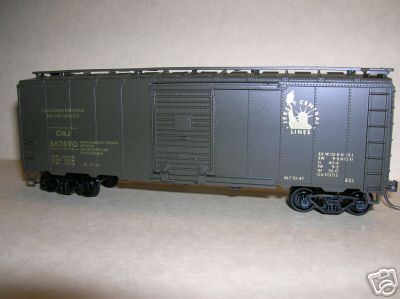Chris,
I wasn't around New England in those years, but 1968 was the year I became intensely interested in railroading. Maybe some observations of what equipment was being used in that time frame would be helpful to you.
Mention was made of grain traffic. In those years, small elevators were still shipping grain, much of it still in boxcars. Standard 40 & 50' boxcars with sliding doors were used. A large plug called a grain door, made of planks and heavy cardboard, was installed inside the door opening. The elevator spout was inserted into a space between the top of the grain door and the top of the door opening to fill the car. The sliding door was then closed and a seal applied. Unloading involved a shovel.
Athern actually sold 40' grainloader HO boxcars, with a small inspection door at the top of the sliding door.
High cube boxcars made their first appearance about then. At first, they were simply extra height 40' or 50' cars. Then, in the late 60's, the 89' hi-cubes appeared. They were much more common then than now. I suppose much of their former traffic now travels in containers.
89' flat cars for TOFC appeared, but no articulated TOFC flats yet. Trailers on flats were common, but containers were not. I don't think containers were standardized yet.
89' auto racks were in use then, but they were open-sided, not enclosed like they are now.
Wooden bodied, steel underframe boxcars and reefers were still in use. Most reefers were mechanical, but ice-cooled cars were still being used. Insulated box cars were common.
All freight trains, except mixed freight-passenger trains, used cabooses. Mixed freight-passenger trains were still in use. The passenger cars had to be blocked next to the locomotives if they were steam-heated. In that case, a caboose would be used, too. If the passenger cars had self-contained heating units, they could be carried behind the freight cars and serve as a caboose.
Standard, non-streamlined passenger cars were still in use, especially head-end cars and cars used on secondary trains.
Motive power was a mix of first and second generation Diesels. Virtually all Diesel locomotive models produced after WWII were still in service. Passenger trains were heated (and sometimes cooled) by steam.
Steam locomotives were not used, but were still in evidence. Locomotive tenders were often seen used as water cars in work train service. Not all the retired steamers had been scrapped-you might sometimes see some rusting away in a dead line.
Track maintenance crews were still housed in camp cars when on the road. These cars were almost always old heavyweights. Each railroad tended to have a standard color for their work train equipment: everything from locomotive tenders to camp cars would be painted the same standard color.
Steam power was still in use in the Engineering Department. Pile drivers; rotary snow plows, cranes would either be powered by steam or Diesel.
The steam locomotives may be rusting away in the weeds, but roundhouses and turntables were still in use. Water towers and coaling docks were generally still standing. They were expensive to dismantle, and their removal was not a high priority.
I hope this gives you some helpful ideas.
Les
